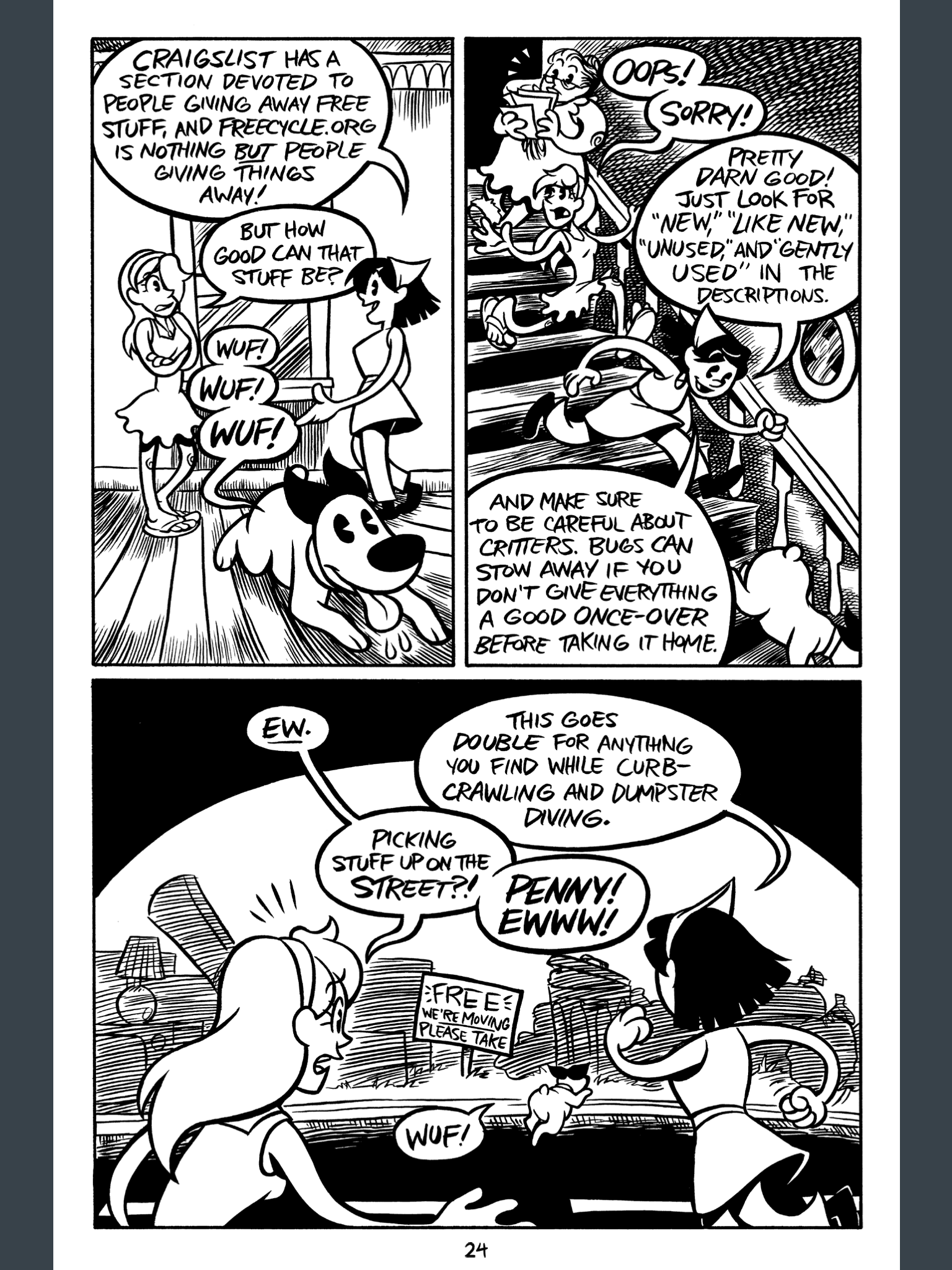You have just read a blog post written by Jason McIntosh.
If you wish, you can visit the rest of the blog, or subscribe to it via RSS. You can also find Jason on Twitter, or send him an email.
Thank you kindly for your time and attention today.
I purchased Poorcraft: The Funnybook Fundamentals of Living Well on Less as a DRM-free, five-dollar PDF after a friend posted one of its panels on Twitter. I fell instantly in love with Diana Nock’s artwork, with rubbery, noodly characters influenced as much by pre-war American animation as by the cartoons of our post-Spongebob present.
The sample of C. Spike Trotman’s writing made the subject matter clear, too: a comics-format guide to independent living on a budget, framed as a Socratic dialog between the frugal, bandana-clad Penny and her pound-foolish pal Mil. Over the couse of a day, Penny shows her ever-skeptical friend how to find cheaper digs, live without a car, value thrift-store clothes and home-cooked meals over pricier alternatives, and start digging herself out of a personal-finances hole.

Overall, I quite enjoyed all hundred-fifty-odd pages of this comic book — even though I skimmed over several of those pages, especially during its occasional sideslips into spot-illustrated lists of chicken recipes or hand-drawn comparative charts of U.S. health care options. It met my expectations of being the book I wish I’d read as a 23-year-old living in my very first by-myself apartment after college, rather than Bill and Ruth Kaysing’s Eat Well for 99¢ a Meal. Poorcraft covers a lot more ground, and in a much more digestible way. While I do not reside in its target audience of those new to independent living — whether by youth or by misfortune — I still gleaned some personally and immediately relevant advice from it. I need to buy some plane tickets this week, as well as refresh my wardrobe for the summer, and now I have some updated ideas about accomplishing both for less dosh.
I found myself sympathizing more than intended with doubtful Mil about the chapter on food, though, and this might come directly from my negative personal experience with the Kaysings’ classic a long time ago. I believe strongly in success through modest changes. In Poorcraft, Penny wants to show Mil how not to eat out all the time — an excellent goal! However, her solution to this matches the Kaysings’: buy staples like rice and potatoes in bulk, get a cast-iron skillet and keep it seasoned, find a good kitchen knife and keep it sharp. If you can, tend a garden, either in a plot outside or in a carefully constructed containers lined with sand and crushed styrofoam. Then learn how to build all your meals from these basic foods and tools.
Reading Eat Well as a life-newbie, I loved the novelty of this idea, and I distinctly remember gathering a lot of stuff as directed, excited to begin. And after two or three failures to make a basic potato pancake, the first recipe in the book, I gave up. Thus I basically lived like savings-free Mil for the next 15 years, until finally rescued from my wasteful bachelorhood. The blame lay with me, of course, and not the book. But I wonder how differently it might have gone had I instead read a book advising me how to become a smarter shopper of prepared foods and other easier-to-prepare home meals, rather than go directly from zero experience to full, varsity-level self-sustenance?
To its credit, Poorcraft does spare some attention to smarter can-and-carton shopping, pairing it with the entirely valid admonition that diligently collecting and applying coupons can stretch one’s grocery-dollar to surprising lengths. But I did find the balance between the strategies off: I can’t help but feel that an empty-fridger who gets dinner delivered every night needs basic lessons in driving a shopping cart more than intimidating advice on using a whetstone.
This complaint of mine just comes down to a differing opinion on informational organization, though. (Perhaps an Advanced Poorcraft appendix?) I really did dig this book! One of its back-cover blurbs compares its role to that of Dr. Seuss’s Oh, the Places You’ll Go, and I do in fact hope it finds its way into the hands of many independent life-starters for many years to come.
Next post: A few principles for a healthy Twitter timeline
Previous post: Email etiquette and character-set mismatches
To share a response that links to this page from somewhere else on the web, paste its URL here.